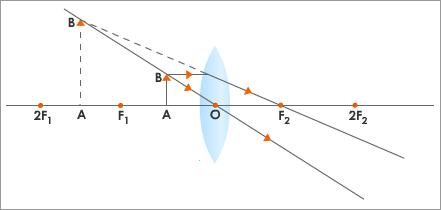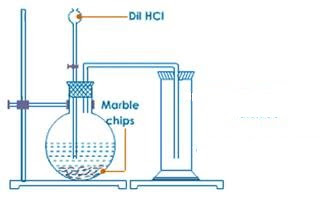SEE SCIENCE SOLUTION -2075(2019) RE-11'AP'(Province No.1)
Answer the following questions: 15x1=15 Group A
a. What is the value of acceleration due to gravity at the pole of the earth?
Ans. The value of acceleration due to gravity at the pole of the earth is 9.83 ms-2.
b. What is an alternative source of energy?
Ans. Those sources of energy that are used to reduce the load of non-renewable sources of energy are called alternative sources of energy.
c. In which two factors do heat gained or heat lost depend upon?
Ans. Heat gained or lost depends upon the mass of the body and the specific heat capacity of the body.
d. Define converging lens.
Ans. A lens that is thick in the middle and thin in the edges is known as a converging or convex lens.
e. What is a transformer?
Ans. The transformer is a device that converts high voltage AC to low voltage AC of the same frequency and vice versa.
f. Write the type of given chemical equation.
C+O2→CO2 b. 2KClO3→2KCl + 3O2
Ans. Addition reaction Ans. Decompositions reaction
g. Define neutral salt.
Ans. Salts formed by the chemical reaction between strong acids and strong bases or vice versa are called normal or neutral salts.
h. Name any two ores of iron.
Ans. The two ores of iron are:
a. Hematite b. Magnetite
i. Write the general formula of alkenes.
j. Write the name of two species of silkworms cultivated in Nepal.
Ans. The name of two species of
silkworms cultivated in Nepal are;
a. Seri silkworm (Bombyx mori)
b. Eri silkworm (Attacus ricini)
k. Write the name of the vein in which pureblood flows.
Ans. Pureblood flows in the Pulmonary
vein.
l. Write any two chromosomal disorders caused by sex chromosomes.
Ans. The two disorders are:
a. Downs’ syndrome b. Turner’s syndrome
m. What is the part of the plant called that is used for root in grafting?
Ans. The part of the plant used for root in grafting is called stock.
n. Mention any two effects of water pollution.
Ans. The two effects of water pollution are:
a. It causes an imbalance in the ecosystem.
b. It causes a lot of harm to aquatic life.
o. In which era were owls and flowering plants evolved?
Ans. The owls were evolved in the
Cenozoic era and flowering plants were evolved in the Mesozoic era.
Group'B' 13x2=26
2. Kathmandu lies at high altitude than Biratnagar from sea level.
Where does an object have more weight between two places? Give reasons.
Ans. The object will have more weight in
Biratnagar compared to Kathmandu. The weight of the object is directly proportional
to the value of g (w=mg). The value of ‘g’ is more in Biratnagar as it lies in a
lesser altitude compared to Kathmandu due to less radius. The weight of the object
is directly proportional to the value of g (g ∝ 1/r2).
3. In the context of Nepal, hydropower should be given more
priority rather than fossil fuels. Why? Justify with two reasons.
Ans. Hydropower is the most potential source of
energy in Nepal. Nepal is the second richest country after Brazil in
hydroelectric power potential due to its many rivers. Hydroelectricity is cheaper
in the long term. It's a renewable and pollution-free source of energy.
4. What happens if an egg is kept in two beakers containing pure
water and saturated salt solution? Why?
Ans. The egg will sink in the beaker containing
pure water but it will float in the beaker containing salt solution. This is
because pure water has less density than that of the egg so the egg cannot
displace water equal to its weight and it sinks. But salt on mixing with water
increases the density of the water and hence the up-thrust. As a result, the
egg can displace water equal to its own weight and float.
5. Mention any two reasons for using nichrome wires in an electric
heater.
Ans. The two reasons for using nichrome wire are:
i.
It has high
resistance.
ii.
It does not
oxidize even at a very high temperature of about 9000C.
6. Write any two characteristics of the modern periodic table.
Ans. The two characteristics are given below.
I.
It is based
on increasing atomic number
II.
Elements in the modern periodic table are
arranged in 7 periods and 18 groups.
7. Write the balanced chemical reaction between Aluminium metal and
dilute hydrochloric acid. Mention the type of reaction with reason.
Ans. 2Al+ 6HCl→2AlCl3+ 3H2 ↑
This is a displacement reaction.
8. Write the structural formula of glycerol and write anyone use
of ethyl alcohol.
Ans.
The structural formula of glycerol is:
9. Write any two functions of organic fertilizers.
Ans. The two functions of organic
fertilizers are;
i.
Organic
fertilizers increase the organic matter content of soil.
ii.
It improves
soil texture, water retention and resistance to erosion.
10. Write two differences between axon and dendrites.
Ans. The differences between axons and
dendrites
|
Axons |
Dendrites |
|
Axons carry impulses away from the cell body. |
Dendrites carry impulses inwards and towards the
cell body. |
|
Axons are much longer compared to dendrites. |
Dendrites are short and heavily branched in
appearance. |
11. Write
two differences between systemic and pulmonary blood circulation.
Ans. The differences between them are:
|
Systemic
circulation |
Pulmonary
circulation |
|
It moves blood between the heart and the rest of
the body. |
It moves blood between the heart and the lungs. |
|
It is composed of inferior and a superior venacava,
aorta, and other small vessels. |
It is composed of a pulmonary artery and vein. |
12. Which
process is represented by the given chart? According to the process write down
the differences between (44, XX) and (44, XY).
|
Sperm→ |
22 + X |
22 + Y |
|
22 + X
|
44+XX |
44+XY |
|
22 + X
|
44+XX |
44+XY |
Ans. The process of sex determination in human beings is shown by the given chart.
The number 44 shows the number of
autosomes in an individual and the XX or XY indicated the sex chromosomes in
the individual. Male individuals have an X and a Y chromosome while female has
two X chromosomes.
13. Write any two differences between drone bee and worker bee.
Ans. The differences between them are:
|
Drone bee |
Worker bee |
|
They are male. |
They are female. |
|
They are larger in size than workers. |
The size of workers is the smallest among the caste
of bees. |
14. Why is meteor generally finished before reaching the earth's
surface?
Group'C' 6x3.0=18
15. What is the condition for an object to sink in water? The
cross-sectional area of piston A1 and A2 is 50 cm2
and 0.2m2 respectively. How much load can lift in piston A2
if 250N force is applied on piston A1?
In order for an object to sink, it
should not be able to displace water equal to its own weight.
Solution:
Cross-sectional
area of small piston (A1) = 50cm2=0.005m2
Cross-sectional
area of large piston (A2) = 0.2m2
Force
applied on small piston A1 (F1) = 250N
Force exerted on large piston (F2) =?
According to
Pascal’s law
A1/F2=F1/A2
0.005/F2=250×0.2
Therefore,
F2=10,000N.
Therefore,
piston P2 can lift 10,000 N load in A2.
16. Prove that heat lost or gained by an object is equal to the
product of the mass of object, specific heat capacity and change in temperature.
Ans. When a hot body is cooled, it gives out heat.
As a result, the temperature of the body falls but when a cold body is heated,
it absorbs heat and its temperature rises.
It has been proved that heat gained or Lost (Q) is
directly proportional to:
I.
to the mass of
the body (m) i.e., Q∝ m... (i)
II.
change in
temperature (dt) i.e., Q∝ dt...(ii)
Combining (i) and (ii), we get,
Q∝ mdt
or,
Q= smdt (where 's’ is a constant i.e. specific heat capacity of the body)
And thus, it is proved that the amount
of heat lost or gained by a body is equal to the product of mass (m), the
Specific heat capacity (s) and change in temperature (dt) of that body.
17. In the given figure, red litmus paper is inserted in solution and colour remains unchanged then what may be contained in the vessel among acid, base and salt solution. How can it be further tested to confirm it?
19.
Draw a neat and clean diagram of the reproductive part of a plant and label its
four major parts.
Ans.
20. What will you suggest to your neighbours so that it can help to
reduce soil pollution? Write any six
suggestions.
Ans.
i.
not to
overuse chemical fertilizers and insecticides.
ii.
to use
organic fertilizers.
iii.
to manage
solid waste at home by reusing, recycling and reducing the waste.
iv.
not let
their animals overgraze or leave the land barren for a long time.
v.
to start
plantation on barren land.
vi. to take part in a sanitation campaign.
Group'D' 4x4.0=16
21.
Draw a ray diagram of an image formed when an object is placed at a distance of
10 m from a convex lens having a focal length of 20cm. Write any two nature of the image.
Calculate the power of the lens.
Ans.
i. Image is Erect and highly magnified
ii. Imafe is virtual.
Given,
Focal length(f)= 20 cm
Power(P) = ?
We know that,
Power of the lens(P)= 100/f (in cm)
P=100/f
Or, P=100/20
P=5D.
Therefore, the power of the lense is 5D.
22. Study the diagram and answer the following questions.
- Which gas is collected in the gas jar?
Ans. Carbon dioxide gas is collected in the gas jar. - Why the gas jar is kept erect?
Ans. The gas jar is kept erect as carbon dioxide is heavier than air and it is collected by upward displacement of air. - What happens when gas is reacted with potassium hydroxide? Write the balanced chemical equation.
Ans. When Carbon dioxide is reacted with potassium hydroxide, it forms potassium carbonate and water. 2KOH + CO₂ → K₂CO3 + H₂O
Mendel's law of segregation states that the hybrids obtained in F1-generation contain two contrasting characteristics
of dominant and recessive nature. These characteristics remain together in
hybrids but do not mix with one another and separate or segregate at the time
of gamete formation in such a way that each gamete gets only one
characteristic, either dominant or recessive.” The gametes of hybrid organisms get purified in successive generations.
24. Write the name of the main Chemical which destroys the ozone layer.
How is the ozone layer depleted by that chemical? Describe with Chemical equation.
Ans. The destruction of Ozone exceeds the formation of
ozone which is called ozone layer depletion. The main chemical which destroys the ozone layer is chlorofluorocarbons (CFCs).
When the CFCs come into contact with UV rays, their
individual components are freed from the whole. i. e. UV rays dissociate CFCs and
form nascent Chlorine.
CFCl3+ UV rays
→ CFCl2 + Cl
This chlorine atom reacts with the ozone (O3) molecule and
produces chlorine monoxide and an oxygen molecule.
Cl+O3→ClO+O2
Nascent Oxygen (O) dissociates ClO in to free chlorine
atom and an Oxygen molecule. In this way, the free Chlorine atom regenerates again to destroy another ozone molecule.
ClO+O.→Cl+O2
This cycle continues in the stratosphere and ozone layer depletion takes place.












This comment has been removed by the author.